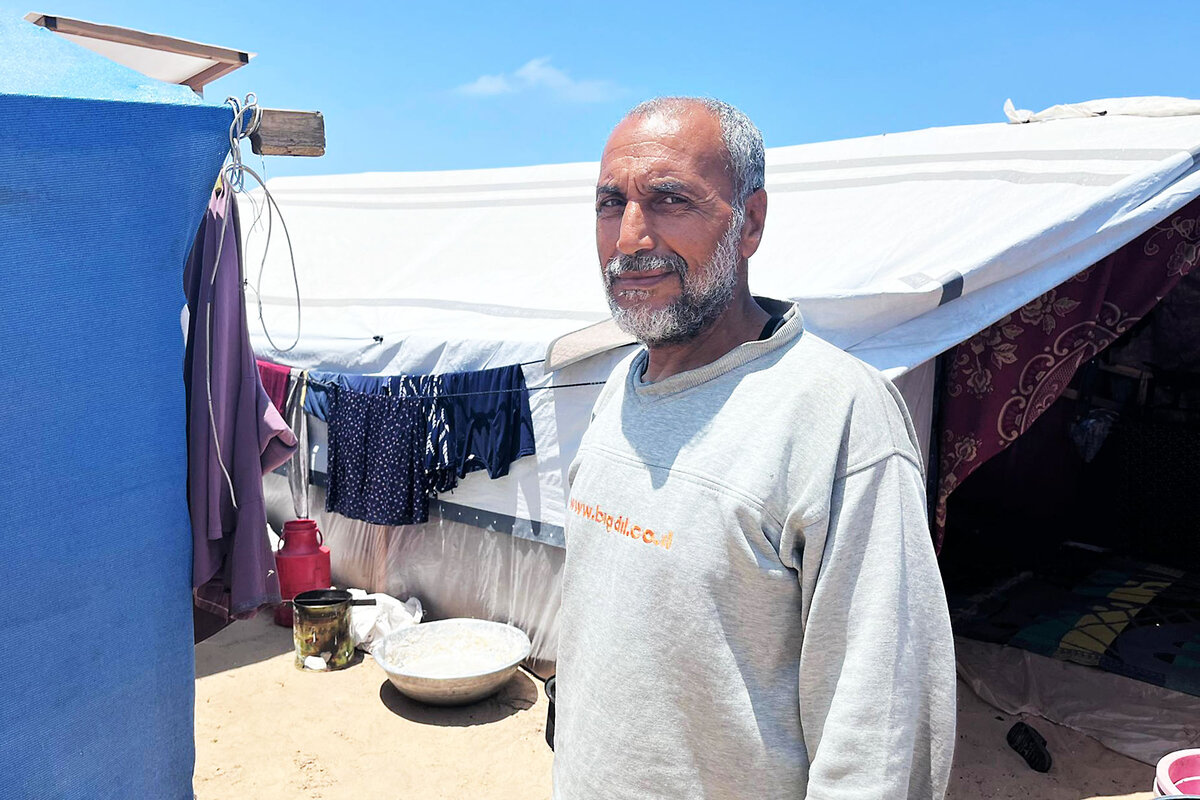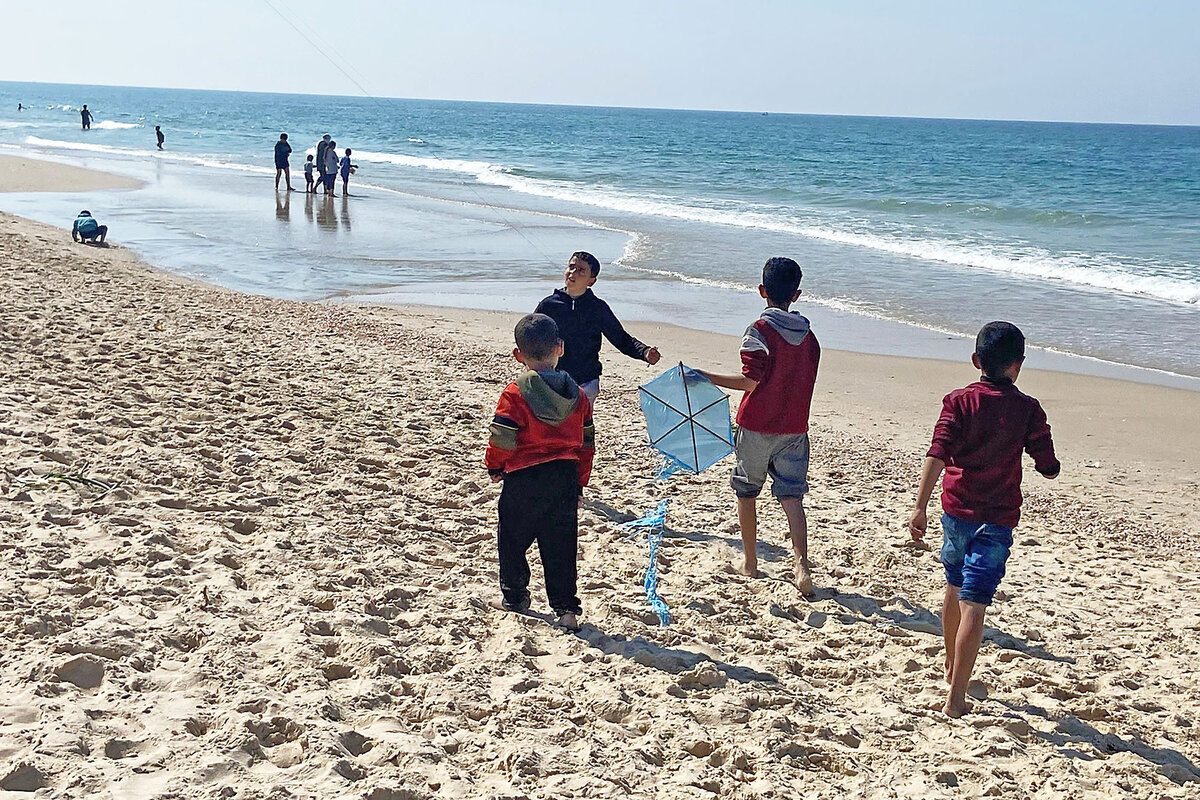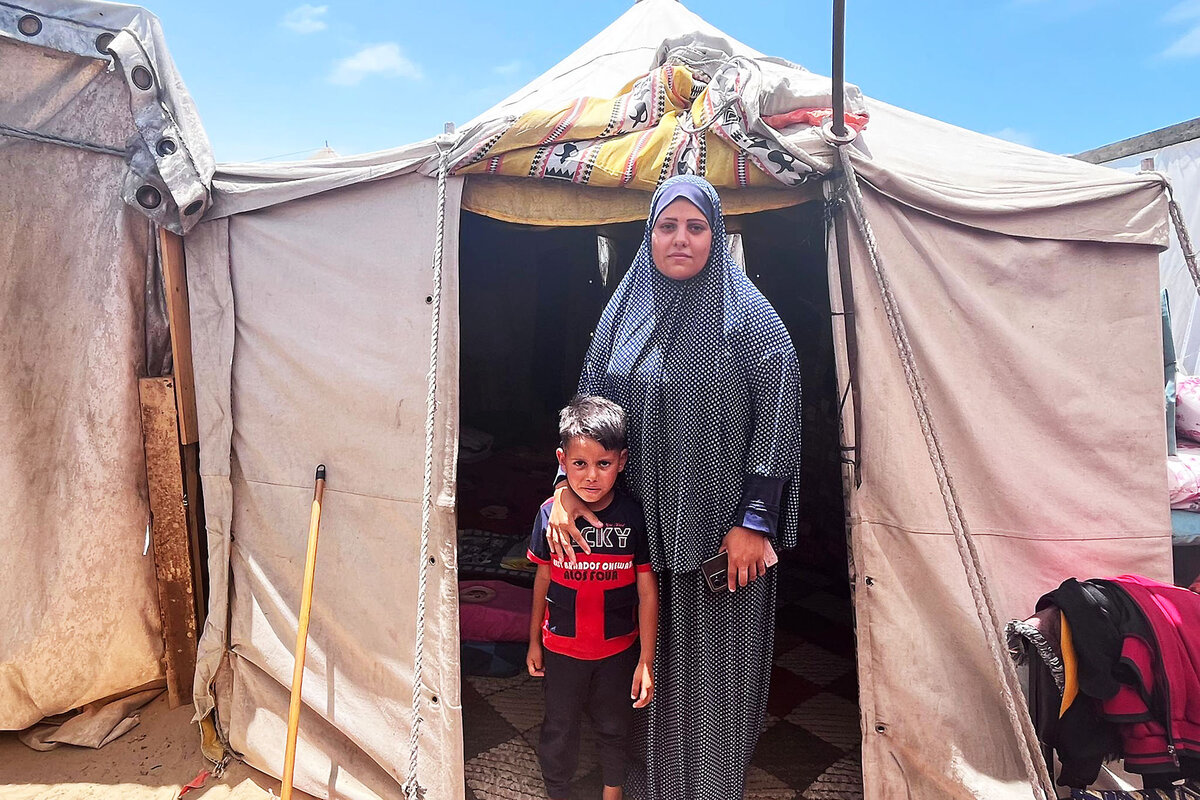Once a seaside getaway, Gaza ‘safe zone’ now feels like a polluted prison
Loading...
| Al-Mawasi, Gaza Strip
For years a rare seaside escape for Palestinians blocked by an Israeli siege, now a sweltering sea of tents, Gaza’s Al-Mawasi coast has become unrecognizable.
Only eight months ago, Palestinians held picnics on Al-Mawasi’s pristine sandy beach or went for romantic walks to watch the sun set over the Mediterranean.
Now garbage is piling up, open sewage flows, and makeshift nylon and canvas tents are packed so densely that it is difficult to see the ocean beyond.
Why We Wrote This
A story focused onPalestinians seeking to survive the Israel-Hamas war have spent eight months looking for safety. Now displaced Gazans describe overcrowded and filthy Al-Mawasi – once a dream vacation destination – in nightmarish terms.
Impoverished and displaced, hawkers shout out their wares for sale: pots, pans, utensils, clothes, and old shoes salvaged from the rubble of Rafah and Khan Yunis. Weary mothers hurry to the shore with buckets to fetch water to bathe their children.
Residents of Gaza who were pushed into this former dream destination against their will say it has become a living nightmare.
Al-Mawasi is a strip of sand dunes and citrus farms 8.7 miles long and a little over half a mile wide. Declared a “safe zone” by Israel, it has emerged as a tent city of last resort for Gaza’s displaced people, now home to an estimated 700,000 to 900,000 Palestinians seeking to escape Israel’s military offensive in the south.
An area constituting some 3% of the densely settled Gaza Strip’s 141 square miles, it now holds more than one-third of Gaza’s population of 2.2 million people.
“We used to come to a recreational resort,” says Omar Hajjar, who, along with his six children, used to view Al-Mawasi as an idyllic getaway. “We would bring a pot of tea, coffee, a chicken to grill or ready-made food and enjoy quality time with family and friends.”
Driven to the strip of coast May 28 after an Israeli strike in Rafah killed dozens of already displaced Palestinians, Mr. Hajjar was shocked at what his family found.
“It’s polluted; it’s crowded. The conditions are unsanitary,” Mr. Hajjar says as he navigates a narrow sandy ally between tents of canvas and nylon. “This is no way for anyone to live or raise a family.”
He, like others now in Al-Mawasi, had avoided coming to the area after hearing from friends and relatives of its dire conditions and crowding.
“I used to come here for tourism, but I never expected to live here,” Mr. Hajjar says.
Childhood memories
Al-Mawasi, an old Palestinian Bedouin fishing village, was once an enclave hemmed in by Israeli settlements on Gaza’s southern coast.
Since Israel’s unilateral withdrawal from Gaza 19 years ago, landowners returned to this prized beachfront area and agricultural lands, while Hamas rented out remaining land plots for tourism and farming projects.
Fathy Abu Sabha, whose family has called Al-Mawasi home since being displaced from Khan Yunis in January, had strong ties to the area.
As a 12-year-old, he would come with his uncle, who worked as a farmhand on area farms and tended to the lush orange, lemon, and date trees.
“We used to run on the beach barefoot; the beach was so clean. We would fly massive kites with bamboo sticks woven together,” Mr. Abu Sabha says. “The wind was so strong it would lift the kites high into the sky.”
Now, the only fluttering is the sound of nylon tent flaps.
Mr. Abu Sabha’s wife, Fatema Jaber, was a professed “beach lover” who would spend at least five days a week down by the water. The ocean then offered a rare escape and a free open expanse – a dramatic break from the cramped refugee camp they called home prior to the war.
Hemmed in by Israeli airstrikes, she says this same beach today has the feeling of a barren prison.
“We’d all go to the sea to feel relief, to walk on the sand and dip our feet into the ocean,” Ms. Jaber reminisces. “Now I hate sand. It is everywhere – in our tents, in our clothes.”
“My husband and I used to come here during our engagement period when we wanted to have fun,” Ms. Jaber says. “Now I see flies and insects; my children are getting infections and skin diseases. It is not safe here.”
She shakes her head, saying, “Now I hate this place. I actually hate any place that I’ve been displaced to.”
What Palestinians here all recall as a pristine beach is today full of visual pollution, foul smells, and the thundering sounds of airstrikes.
“There is no proper sanitation. We walk barefoot and have to jump over sewage water. Garbage is piled up everywhere,” Mr. Hajjar says.
There is no running water to the tent city, residents wait for hours to use the few public toilets, and with only a few hastily assembled field hospitals, international aid organizations warn that diseases like hepatitis A are spreading rapidly.
Precious water
As early summer temperatures soar above 90 degrees along the sunbaked beachfront, water has become a precious resource.
Residents desperately flag down water tankers being brought by aid agencies into the makeshift camp, but they say there is never enough.
“We have to ration water carefully, make every drop count,” Mr. Hajjar says. “It is just one more challenge we face here. We manage because we have to.”
On a scorching June day, children run and jump into the ocean and hop back out to cool down and stave off their feelings of thirst.
Mr. Hajjar sighs. “This is our reality now,” he says. “We make do as best as we can for the sake of our children. We hope things will improve soon.”
Mr. Abu Sabha believes that no matter when and how the conflict ends, Al-Mawasi, and memories of carefree days in Gaza, will be yet another casualty in the war.
“We no longer like this place because we have lived the worst days of our life here,” he says. “Everything has changed.”
Taylor Luck contributed to this report from Tunis, Tunisia.








